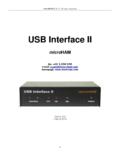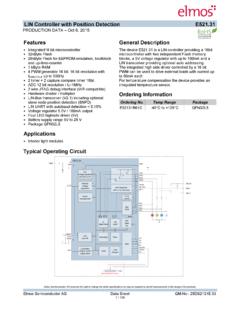Transcription of AXI Reference Guide - Xilinx - All Programmable
1 [ Guide Subtitle] [optional]UG761 ( ) March 7, 2011 [optional]AXI Reference GuideUG761 ( ) March 7, 2011 AXI Reference ( ) March 7, 2011 Xilinx is providing this product documentation, hereinafter Information, to you AS IS with no warranty of any kind, express or implied. Xilinx makes no representation that the Information, or any particular implementation thereof, is free from any claims of infringement. You are responsible for obtaining any rights you may require for any implementation based on the Information. All specifications are subject to change without notice. Xilinx EXPRESSLY DISCLAIMS ANY WARRANTY WHATSOEVER WITH RESPECT TO THE ADEQUACY OF THE INFORMATION OR ANY IMPLEMENTATION BASED THEREON, INCLUDING BUT NOT LIMITED TO ANY WARRANTIES OR REPRESENTATIONS THAT THIS IMPLEMENTATION IS FREE FROM CLAIMS OF INFRINGEMENT AND ANY IMPLIED WARRANTIES OF MERCHANTABILITY OR FITNESS FOR A PARTICULAR PURPOSE.
2 Except as stated herein, none of the Information may be copied, reproduced, distributed, republished, downloaded, displayed, posted, or transmitted in any form or by any means including, but not limited to, electronic, mechanical, photocopying, recording, or otherwise, without the prior written consent of Xilinx . 2011 Xilinx , Inc. Xilinx , the Xilinx logo, Virtex, Spartan, ISE, and other designated brands included herein are trademarks of Xilinx in the United States and other countries. All other trademarks are the property of their respective and AMBA are registered trademarks of ARM in the EU and other countries. All other trademarks are the property of their respective HistoryThe following table shows the revision history for this document:DateVersionDescription of Revisions09/21/2010 Xilinx release in 03/01 Xilinx release in Added new AXI Interconnect features.
3 Corrected ARESETN description in Appendix broken link. AXI Reference (v ) March 7, 2011 Revision History .. 2 Chapter 1: Introducing AXI for Xilinx System DevelopmentIntroduction .. 5 What is AXI?.. 5 Summary of AXI4 Benefits .. 6 How AXI Works .. 6IP Interoperability .. 8 About Data Interpretation .. 8 About IP Compatibility .. 8 Infrastructure IP .. 9 Memory Mapped Protocols .. 9 AXI4-Stream Protocol .. 9 Combining AXI4-Stream and Memory Mapped Protocols .. 9 What AXI Protocols Replace.. 10 Targeted Reference Designs.. 10 Additional References.. 10 Chapter 2: AXI Support in Xilinx Tools and IPAXI Development Support in Xilinx Design Tools.. 13 Using Embedded Development Kit: Embedded and System Edition .. 13 Creating an Initial AXI Embedded System.. 13 Creating and Importing AXI IP.. 13 Debugging and Verifying Designs: Using ChipScope in XPS.
4 14 Using Processor-less Embedded IP in Project Navigator .. 14 Using System Generator: DSP Edition .. 14 AXI4 Support in System Generator.. 14 Using Xilinx AXI IP: Logic Edition .. 17 Xilinx AXI Infrastructure IP .. 18 Xilinx AXI Interconnect Core IP .. 19 AXI Interconnect Core Features .. 19 AXI Interconnect Core Limitations.. 21 AXI Interconnect Core Diagrams .. 22 AXI Interconnect Core Use Models.. 22 Width Conversion.. 26N-to-M Interconnect (Shared Access Mode).. 27 Clock Conversion .. 28 Pipelining .. 28 Peripheral Register Slices .. 29 Data Path FIFOs .. 29 Connecting AXI Interconnect Core Slaves and Masters .. 29 AXI-To-AXI Connector Features.. 29 Description .. 29 Using the AXI To AXI Connector .. 30 External Masters and Slaves .. 30 Table of AXI Reference GuideUG761 (v ) March 7, 2011 Features.
5 30 Centralized DMA .. 32 AXI Centralized DMA Summary .. 33 AXI Centralized DMA Scatter Gather Feature .. 33 Centralized DMA Configurable Features.. 33 Centralized DMA AXI4 Interfaces .. 34 Ethernet DMA .. 34 AXI4 DMA Summary.. 36 DMA AXI4 Interfaces .. 37 Video DMA .. 38 AXI VDMA Summary.. 39 VDMA AXI4 Interfaces.. 40 Memory Control IP and the Memory interface Generator .. 40 Virtex-6.. 41 Spartan-6 Memory Control Block.. 41 Chapter 3: AXI Feature Adoption in Xilinx FPGAsMemory Mapped IP Feature Adoption and Support.. 43 AXI4-Stream Adoption and Support.. 45 AXI4-Stream Signals .. 45 Numerical Data in an AXI4-Stream .. 45 Real Scalar Data Example.. 47 Complex Scalar Data Example .. 48 Vector Data Example .. 49 Packets and NULL Bytes .. 52 Sideband Signals.. 53 Events.. 53 TLAST Events.. 54 DSP and Wireless IP: AXI Feature Adoption.
6 55 Chapter 4: Migrating to Xilinx AXI ProtocolsIntroduction .. 57 Migrating to AXI for IP Cores .. 57 The AXI To PLB Bridge .. 58 Features .. 58 AXI4 Slave interface .. Master interface .. 59 AXI to Bridge Functional Description .. 59 Migrating Local-Link to AXI4-Stream.. 60 Required Local-Link Signal to AXI4-Stream Signal Mapping .. 60 Optional Local-Link Signal to AXI4-Stream Signal Mapping.. 62 Variations in Local-Link IP.. 63 Local-Link References.. 63 Using System Generator for Migrating IP.. 63 Migrating a System Generator for DSP IP to AXI .. 63 Resets .. 63 Clock Enables .. 63 TDATA.. 63 Port Ordering .. 64 Latency.. 65 Output Width Specification .. 65 AXI Reference (v ) March 7, 2011 Migrating Interfaces in System Generator .. 65 Migrating a Fast Simplex Link to AXI4-Stream.
7 65 Master FSL to AXI4-Stream Signal Mapping .. 65 Slave FSL to AXI4-Stream Signal Mapping .. 66 Differences in Throttling .. 66 Migrating HDL Designs to use DSP IP with AXI4-Stream.. 67 DSP IP-Specific Migration Instructions .. 67 Demonstration Testbench.. 67 Using CORE Generator to Upgrade IP .. 68 Latency Changes .. 68 Slave FSL to AXI4-Stream Signal Mapping .. 69 Software Tool Considerations for AXI Migration (Endian Swap).. 69 Guidelines for Migrating Big-to-Little Endian .. 70 Data Types and Endianness .. 71 High End Verification Solutions.. 72 Appendix A: AXI Adoption SummaryAXI4 and AXI4-Lite Signals .. 73 Global Signals .. 73 AXI4 and AXI4-Lite Write Address Channel Signals .. 73 AXI4 and AXI4-Lite Write Data Channel Signals .. 74 AXI4 and AXI4-Lite Write Response Channel Signals .. 75 AXI4 and AXI4-Lite Read Address Channel Signals.
8 75 AXI4 and AXI4-Lite Read Data Channel Signals .. 76 AXI4-Stream Signal Summary.. 77 Appendix B: AXI AXI Reference GuideUG761 (v ) March 7, 2011 AXI Reference ( ) March 7, 2011 Chapter 1 Introducing AXI for Xilinx System DevelopmentIntroductionXilinx has adopted the Advanced eXtensible interface (AXI) protocol for Intellectual Property (IP) cores beginning with the Spartan -6 and Virtex -6 devices. This document is intended to: Introduce key concepts of the AXI protocol Give an overview of what Xilinx tools you can use to create AXI-based IP Explain what features of AXI Xilinx has adopted Provide guidance on how to migrate your existing design to AXINote:This document is not intended to replace the Advanced Microcontroller Bus Architecture (AMBA ) ARM AXI4 specifications. Before beginning an AXI design, you need to download, read, and understand the ARM AMBA AXI Protocol Specification, along with the AMBA4 AXI4-Stream Protocol are the steps to download the specifications; you might need to fill out a brief registration before downloading the to Download the Contents pane on the left, click AMBA > AMBA Specifications > both the ABMA AXI4-Stream Protocol Specification and AMBA AXI Protocol Specification What is AXI?
9 AXI is part of ARM AMBA, a family of micro controller buses first introduced in 1996. The first version of AXI was first included in AMBA , released in 2003. AMBA , released in 2010, includes the second version of AXI, AXI4. There are three types of AXI4 interfaces: AXI4 for high-performance memory-mapped requirements. AXI4-Lite for simple, low-throughput memory-mapped communication (for example, to and from control and status registers). AXI4-Stream for high-speed streaming introduced these interfaces in the ISE Design Suite, release Reference GuideUG761 ( ) March 7, 2011 Chapter 1:Introducing AXI for Xilinx System DevelopmentSummary of AXI4 BenefitsAXI4 provides improvements and enhancements to the Xilinx product offering across the board, providing benefits to Productivity, Flexibility, and Availability: Productivity By standardizing on the AXI interface , developers need to learn only a single protocol for IP.
10 Flexibility Providing the right protocol for the application: AXI4 is for memory mapped interfaces and allows burst of up to 256 data transfer cycles with just a single address phase. AXI4-Lite is a light-weight, single transaction memory mapped interface . It has a small logic footprint and is a simple interface to work with both in design and usage. AXI4-Stream removes the requirement for an address phase altogether and allows unlimited data burst size. AXI4-Stream interfaces and transfers do not have address phases and are therefore not considered to be memory-mapped. Availability By moving to an industry-standard, you have access not only to the Xilinx IP catalog, but also to a worldwide community of ARM Partners. Many IP providers support the AXI protocol. A robust collection of third-party AXI tool vendors is available that provide a variety of verification, system development, and performance characterization tools.
















